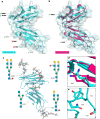Restoring protein glycosylation with GlycoShape
- PMID: 39402214
- PMCID: PMC11541215
- DOI: 10.1038/s41592-024-02464-7
Restoring protein glycosylation with GlycoShape
Abstract
Despite ground-breaking innovations in experimental structural biology and protein structure prediction techniques, capturing the structure of the glycans that functionalize proteins remains a challenge. Here we introduce GlycoShape ( https://glycoshape.org ), an open-access glycan structure database and toolbox designed to restore glycoproteins to their native and functional form in seconds. The GlycoShape database counts over 500 unique glycans so far, covering the human glycome and augmented by elements from a wide range of organisms, obtained from 1 ms of cumulative sampling from molecular dynamics simulations. These structures can be linked to proteins with a robust algorithm named Re-Glyco, directly compatible with structural data in open-access repositories, such as the Research Collaboratory for Structural Bioinformatics Protein Data Bank (RCSB PDB) and AlphaFold Protein Structure Database, or own. The quality, performance and broad applicability of GlycoShape is demonstrated by its ability to predict N-glycosylation occupancy, scoring a 93% agreement with experiment, based on screening all proteins in the PDB with a corresponding glycoproteomics profile, for a total of 4,259 N-glycosylation sequons.
© 2024. The Author(s).
Conflict of interest statement
The authors declare no competing interests.
Figures





References
-
- Schjoldager, K. T., Narimatsu, Y., Joshi, H. J. & Clausen, H. Global view of human protein glycosylation pathways and functions. Nat. Rev. Mol. Cell Biol.21, 729–749 (2020). - PubMed
-
- Stanley, P., Moremen, K. W., Lewis, N. E., Taniguchi, N. & Aebi, M. in Essentials of Glycobiology (eds Varki, A. et al.) Ch. 9 (Cold Spring Harbor Laboratory Press, 2022). - PubMed
-
- Hutter, H. et al. Conservation and novelty in the evolution of cell adhesion and extracellular matrix genes. Science287, 989–994 (2000). - PubMed
MeSH terms
Substances
Grants and funding
LinkOut - more resources
Full Text Sources

